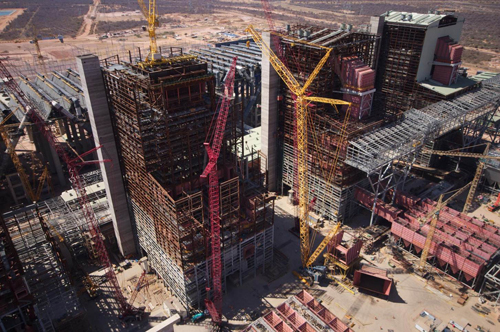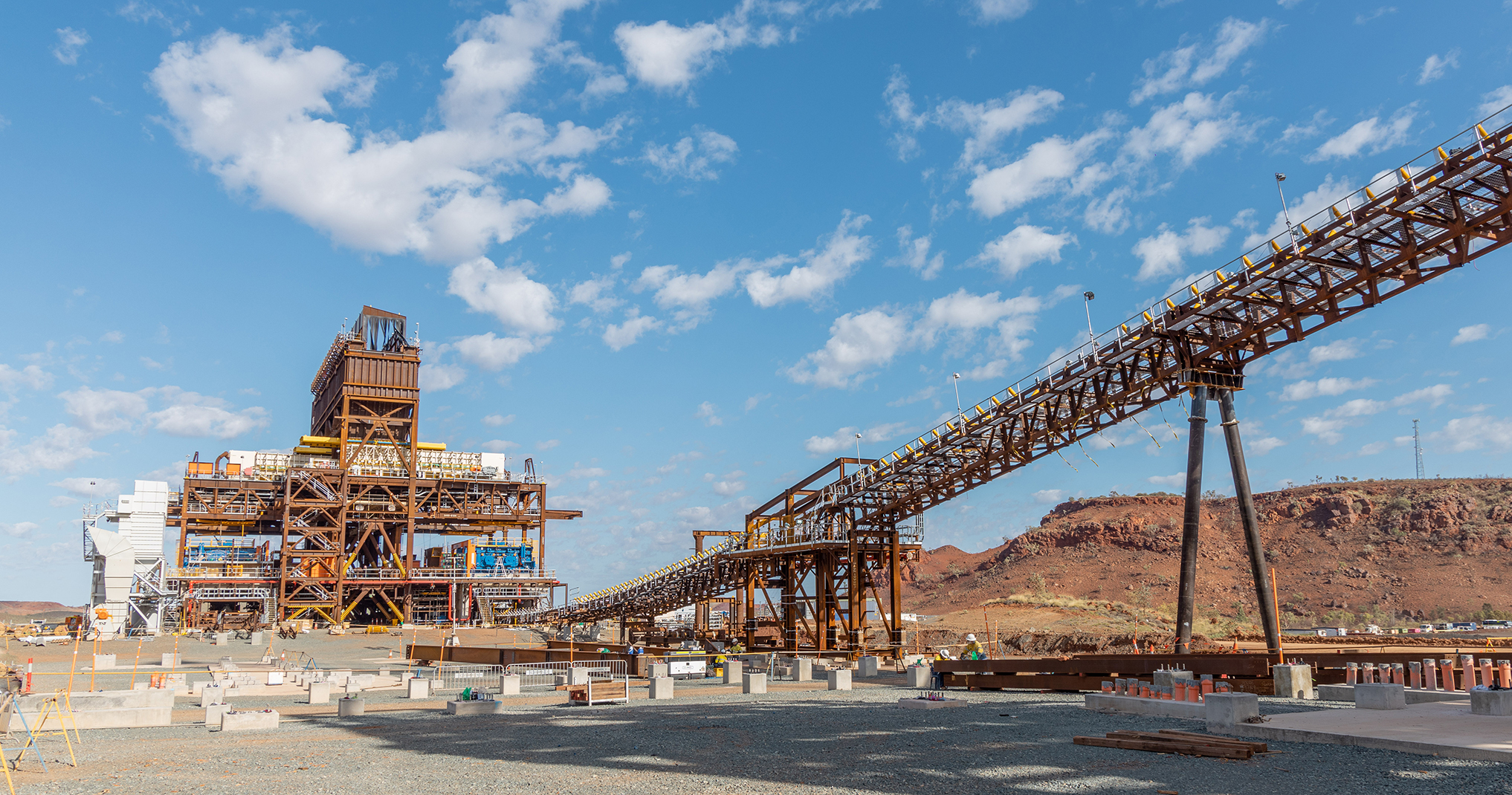
Since we last spoke to Roman Crookes, project manager of the R105 billion Medupi power station, he has refereed a game of two halves. The press has had a field day throughout the three years since June 2010, and any observer could be forgiven for thinking the site has been a battlefield. However in every problem lies an opportunity, and it was good to get a chance to hear firstly about the achievements of the project, then about the good that has come from the setbacks that have been encountered. As Crookes puts it: “This year has been satisfying: we have seen a lot of progress on construction, though unfortunately that progress can get lost in the noise.”
One of this year’s most significant milestones was the conclusion of an agreement between Eskom and Exxaro on a new schedule to supply the huge amounts of coal that will be needed from the Grootegeluk mine. This takes into account the delay in starting Unit 6, the first of the 800 MW units that was due to be completed by the end of this year but will now only be connected to the grid in the second half of 2014. “The infrastructure between us and the mine is now fully established and Eskom has 160,000 tonnes of coal on site,” says Crookes. The coal stockpile capacity on the 900-hectare site is 2.4 million tonnes, to keep all six units fed once they are all commissioned. Eskom now has the option to defer the commencement of coal deliveries to the Medupi power station from March 2013 to the first quarter of 2014. The subsequent rate of coal deliveries will then be increased to take the full volume of the deferred coal over a period of 24 months prior to December 2016.
A second achievement that pleased the project team as they saw plumes of smoke arising for the first time, was the commissioning of the auxiliary boiler, an oil fired plant that produces the steam needed for chemical cleaning and testing Unit 6. This was something of a landmark, the first new boiler commissioned on a construction site in South Africa in the last 20 years. In advance of this too, the bulk fuel oil plant that will be used for the ignition phase of the boiler units as well as running the auxiliary boiler was commissioned.
The water treatment plant is nearing completion too, as are vital fire protection and auxiliary cooling systems. All that is needed now is for the number 6 boiler to be commissioned – the turbine for that unit has been rotated to test bearing clearances and the lubrication. The Unit 6 Generator Transformer has been back-energised, which means it is now connected to the grid. Very recently the turbine contractor Alstom installed its final stator. All the plant really needs now is a supply of steam.
However it is well documented that the steam will take a little longer to flow than originally envisaged. Given the perfect storm of problems the plant has faced, a few months’ delay is not surprising. With the completion of some of the civil works the number of workers on site has come down from the original 18,000 to around 16,000, 95 percent of them South Africa nationals. Much of the delay has been caused by labour issues affecting the seven different unions that represent them. A lot has happened in the labour relations field over the last three years. A Project Labour Agreement (PLA) was entered into by contractors and unions, and worked well until at the back end of 2012 when some of the unions withdrew.
This introduced a fracture among the unions themselves, says Crookes, and that forced Eskom to step in and intervene, working with the unions and contractors to forge a new agreement to replace the PLA, that this time included Eskom as a signatory and regulates labour relations at both Medupi and the other large plant under construction, Kusile. Among other things, the new Partnership Agreement (PA), signed on June 12 this year, prescribes a minimum wage for all hourly-paid contractor employees; standardised pay rates within each company, across companies and within the same industries; and allows parties to appoint a task team to address skills development and training needs. “The PA irons out the kinks in the PLA that caused much of the tension,” Crookes says.
The period that led up to the PA had seen some disruption, and that disruption has continued, with a wildcat strike on July 24 that resulted in property damage on site. This was caused by miscommunication around the question of pay for commuting time for the approximately 50 percent of workers who live within a 70 kilometre radius of the plant. Workers are affected differently depending on precisely how far from the site they live. The situation is now settling down well, though, as the workers themselves appreciate that their new minimum wage is well above national levels in the construction industry.
The new PA is nothing less than a game changer for the entire South African construction industry, Crookes claims. “Eskom, as a client, is now actively influencing the construction environment for the better. The new PA agreement we have struck is now being used as a reference point for the unions when they are negotiating other contracts.”
On its own, the delay caused by labour disruption would account for much of the slippage in project delivery. However severe technical problems have played their part too. One issue was where the boiler contractor Hitachi fell foul of an Inspectorate of Machinery code compliance issue and had to review 180 welds in the pressure parts circuit, four of which had to be retrofitted – all additional work that had not been planned for. A second more serious problem arose when it was discovered that the subcontractor responsible for post welding treatment, a critical process in which welds are de-stressed, had fraudulently created charts in a sophisticated scam that left uncertainty as to how thoroughly the weld had been checked. In short every weld – 9,000 of them – had to be re-checked. The sophisticated fraud led to a criminal investigation and further delays.
These technical problems have all been identified and addressed using well understood procedures that are part of any project management process. Medupi is a critical national asset, and any delay is to be regretted. However the labour relations issues are less predictable and negotiations involving powerful unions are sensitive in the run-up to national elections. What cannot be disputed is the fact that the project has been a great boost to the local manufacturing and economy.
The Medupi power station project created a lot of skills development within the country. “Once we started building Medupi and Kusile we effectively introduced a lot of manufacturing capability back in to South Africa,” Roman Crookes points out. “For example for the first time in 20 years we now have the ability to build boilers here in South Africa. Technically we can now export boilers, which is a huge step in the right direction.”
Medupi’s local sourcing and industry creation policy has undoubtedly had a big impact in the Limpopo region and nationally. The decision to build a third large power station, recently announced by the South African cabinet, will probably be implemented once the Medupi and Kusile projects are complete in 2018, adding a combined 9,600MW to the national grid. This should finally put an end to the electricity supply challenges that have affected South Africa since 2008, costing the economy billions of Rand in lost production and economic growth.
Thus the social impact has been significant, to Crookes’ great satisfaction. “People are becoming employed for the first time; given skills for the first time; paid for the first time! And to sustain the impetus once construction is complete we have the Medupi Leadership Initiative where we work closely with the contractors to produce opportunities for post construction employment in different infrastructure-related projects.”
The third power station will eventually mop up many of the newly-skilled people, and there are other important upcoming programmes in the pipeline, he says. “The government has said it wants to place a rail hub in the Lephalale region. That will need a lot of civil and mechanical trades to build it and lessen the impact of unemployment on the local community once all the Medupi units start supplying power to the national grid.”
Written by John O’Hanlon, research by Vincent Kielty and Robert Hodgson



 Eskom.Medupi-Africa-Energy-Nov13-Bro-s.pdf
Eskom.Medupi-Africa-Energy-Nov13-Bro-s.pdf









